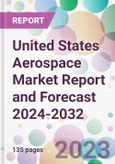According to the report, the United States aerospace market is projected to grow at a CAGR of 2.40% between 2024 and 2032. Aided by technological advancements, increased defence spending, and the revival of commercial air travel, the market is expected to grow significantly by 2032.
Aerospace encompasses the design, development, and production of aircraft, spacecraft, satellites, and missiles. The industry plays a pivotal role in bolstering the nation's defence capabilities, ensuring efficient commercial air travel, and driving the exploration of outer space. The U.S. aerospace sector holds a significant global position, given its vast production output, technological leadership, and strategic defence role.
One of the major drivers for the United States aerospace market growth is the country's substantial investment in defence. With evolving geopolitical dynamics and emerging threats, the U.S. Department of Defense has continuously expanded its budget allocation for aerospace technologies, ensuring state-of-the-art fighter jets, drones, and missile systems. The procurement of advanced aerospace equipment ensures that the nation remains at the forefront of global defence capabilities.
As per the United States aerospace market analysis, the resurgence of commercial air travel, following a brief downturn due to global health crises, has significantly boosted the aerospace industry. As international borders reopen and the pent-up demand for travel is actualised, airlines are updating and expanding their fleets. This revitalisation of the commercial segment, coupled with the rise of new entrants in the aviation sector, ensures consistent demand for aircraft, parts, and maintenance services.
Space exploration and satellite deployment have also emerged as robust avenues that propel the United States aerospace market demand. The U.S., with its mix of legacy space institutions and innovative private players like SpaceX and Blue Origin, is spearheading missions to the Moon, Mars, and beyond. The burgeoning commercial space industry, focusing on satellite broadband, space tourism, and extraterrestrial mining, presents a plethora of opportunities for the U.S. aerospace market.
Moreover, the constant drive for innovation in aerospace technology, from the development of more fuel-efficient engines to the integration of AI and IoT in aircraft systems, are some of the crucial United States aerospace market trends that ensure the sector's steady advancement. Research into Urban Air Mobility (UAM) and electric aircraft showcases the industry's commitment to addressing environmental concerns and urban transportation challenges.
Aerospace encompasses the design, development, and production of aircraft, spacecraft, satellites, and missiles. The industry plays a pivotal role in bolstering the nation's defence capabilities, ensuring efficient commercial air travel, and driving the exploration of outer space. The U.S. aerospace sector holds a significant global position, given its vast production output, technological leadership, and strategic defence role.
One of the major drivers for the United States aerospace market growth is the country's substantial investment in defence. With evolving geopolitical dynamics and emerging threats, the U.S. Department of Defense has continuously expanded its budget allocation for aerospace technologies, ensuring state-of-the-art fighter jets, drones, and missile systems. The procurement of advanced aerospace equipment ensures that the nation remains at the forefront of global defence capabilities.
As per the United States aerospace market analysis, the resurgence of commercial air travel, following a brief downturn due to global health crises, has significantly boosted the aerospace industry. As international borders reopen and the pent-up demand for travel is actualised, airlines are updating and expanding their fleets. This revitalisation of the commercial segment, coupled with the rise of new entrants in the aviation sector, ensures consistent demand for aircraft, parts, and maintenance services.
Space exploration and satellite deployment have also emerged as robust avenues that propel the United States aerospace market demand. The U.S., with its mix of legacy space institutions and innovative private players like SpaceX and Blue Origin, is spearheading missions to the Moon, Mars, and beyond. The burgeoning commercial space industry, focusing on satellite broadband, space tourism, and extraterrestrial mining, presents a plethora of opportunities for the U.S. aerospace market.
Moreover, the constant drive for innovation in aerospace technology, from the development of more fuel-efficient engines to the integration of AI and IoT in aircraft systems, are some of the crucial United States aerospace market trends that ensure the sector's steady advancement. Research into Urban Air Mobility (UAM) and electric aircraft showcases the industry's commitment to addressing environmental concerns and urban transportation challenges.
Market Segmentation
The market can be divided based on type, operation, body type, and aircraft type.
Market Breakup by Type
- Structures
- Airframe
- Engine and Engine Systems
- Cabin Interiors
- Landing Gear
- Avionics and Control Systems
- Communication System
- Navigation System
- Flight Control System
- Health Monitoring System
- Electrical Systems
- Environmental Control Systems
- Fuel and Fuel Systems
- MRO
Market Breakup by Operation
- Autonomous Aircraft
- Manual
Market Breakup by Body Type
- Wide Body
- Narrow Body
Market Breakup by Aircraft Type
- Commercial Aviation
- General Aviation
- Military Aviation
- Others
Competitive Landscape
The report looks into the market shares, plant turnarounds, capacities, investments, and mergers and acquisitions, among other major developments, of the leading companies operating in the United States aerospace market. Some of the major players explored in the report are as follows:- Lockheed Martin Corporation
- Raytheon Technologies Corporation
- Boeing Company
- General Dynamics Corporation
- Northrop Grumman Corporation
- GE Aviation
- L3Harris Technologies
- Leidos, Inc.
- Others
Table of Contents
1 Preface2 Report Coverage - Key Segmentation and Scope4 Key Assumptions6 Market Snapshot7 Industry Opportunities and Challenges11 Key Trends and Developments in the Market
3 Report Description
5 Executive Summary
8 United States Aerospace Market Analysis
9 Market Dynamics
10 Competitive Landscape
List of Key Figures and Tables
Companies Mentioned
- Lockheed Martin Corporation
- Raytheon Technologies Corporation
- Boeing Company
- General Dynamics Corporation
- Northrop Grumman Corporation
- GE Aviation
- L3Harris Technologies
- Leidos Inc.
Methodology

LOADING...








